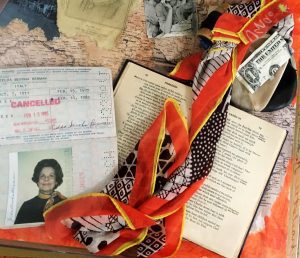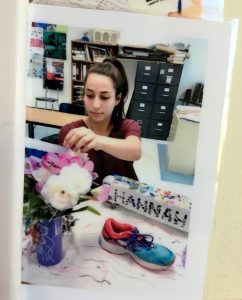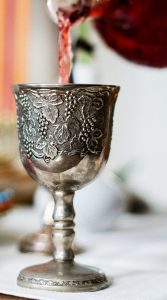
Oct 13 2022 The Power of Family Objects: Passing on Stories to Your Teen Grandchild
Our closets and cabinets are filled with ordinary personal treasures — a pitcher from an aunt, a grandfather’s Kiddush cup, trinkets you collected in a foreign country, a pocket watch that no longer works. Sometimes we forget the potent family stories they hold. We have kept these objects either for a utilitarian purpose or because they remind us of a person or an event beloved or important to our family and ourselves.

Some have monetary value, some don’t; yet they all hold within them family stories. Some items are overtly Jewish, and others are not religious at all; all of them can be used to start conversations about family history.
Each object holds a story that can be told in a number of ways. You can talk about how the object was used, its significance in family lore, its craftsmanship or artistic qualities. You can talk about how you came upon the item and why it has meaning to you and the family as a whole.
The story could be historical or emotional, or it might demonstrate a Jewish value that is important to your family such as kindness or creativity. It could be a story of a time you helped another or a time you were thanked for your kindness. It could be the story of a trip, or the story of a chance find on a sidewalk.

The point of showing the objects and telling their stories is to trigger your own memories and to share those memories with your grandchildren.
The story can inform any age group or personality; it is the way you tell the story that has resonance. This is a chance for you to be creative, to take a trip down memory lane, and bring along a precious companion while you do it. Many grandparents have told me how astounded both they and their grandchildren were at finding such treasures buried in their home closets.
B-Mitzvah can be the perfect time for this sharing because, like any transformative moment — starting school, going to college, getting married, becoming a parent — it is imbued with meaning and often feels momentous to the teen.
 Here’s an example:
Here’s an example:
You might show your B-Mitzvah grandchild their great-grandfather’s Kiddush cup, saying, “Your great-grandfather received this Kiddush cup on his Bar Mitzvah. I used it at my own Bat Mitzvah. When you become B-Mitzvah in February, I will give it to you. Would you like to use it, either leading up to or during your ceremony? If yes, how could you imagine doing so? These objects resonate differently for each of us so feel free to interpret its use in your own way.”
If your grandchild has expressed interest in the Holocaust or Jewish history, you may discuss how the cup was smuggled out of the former homeland and how the legacy of the Holocaust and/or other persecutions of Jews affected the family. Your grandchild might want to share some of these stories before leading the blessing over wine at a Friday night dinner, Shabbat service, or at the B-Mitzvah ceremony itself, or incorporate it into a d’var Torah or thank you speech.
Below are 4 steps to engage your B-Mitzvah grandchild in finding meaning in family objects:
1. Look in your closet.
Decide on three or four objects that have family stories to tell (a Jewish ritual object, pot, piece of jewelry, decorative object, or photo). It could also be an object that has been passed down through generations.
Most importantly, be sure to pick items that have meaning to you. It’s hard to tell an engaging story when you yourself are not inspired.
 2. Plan the story.
2. Plan the story.
How do you want to present this story to your teen grandchild? Think about their interests, previous conversations you’ve had, how your grandchild has engaged at, say, the Passover seder or family dinners. If you’re telling an historical story, audit your history and ensure you have the facts correct. Think about the point of view from which you will be telling the story. Anticipate how your grandchild’s interests might differ from your own and try to incorporate their interests into the story. For example, if the object of interest is a tallit or a scarf, you might be interested in its history (who owned it and when, how it was used) but the teen may be more interested in its artwork or embroidery.
3. Adapt the conversation to what the teen responds to.
This is not a lecture. It is a way to learn about your grandchild’s interests just as much as it is a way for them to learn about their family history. Ask the teen questions about the object, what they notice or what it makes them think about. Ask what they wish they knew about it or the previous owners.
Be prepared that your grandchild might need to be kept entertained. Just like the four children in the Passover haggadah, we have to adapt the way we tell stories so that they resonate with the child and their attitude at the moment. You might ask your grandchild to choose an object that they would like to know more about. You might ask them to lead the conversation or guess why you have treasured a particular item.
Try to appeal to the child’s appreciation of history, language, other cultures, or their general intellectual curiosity.
4. Ask your grandchild to video the story as a keepsake or to send to others in the family.
Or they can do an audio recording on their phone and save that. Another option is to use a free digital keepsake site like BublUp to save and share the recordings.
![]() Click HERE to see a family cabinet video.
Click HERE to see a family cabinet video.
5. Invite your grandchild to incorporate the object into their B-Mitzvah experience.
They might begin using the ritual object every Shabbat or they might put it in a prominent palace in their own room or in a box of treasures they keep in their top drawer. They can incorporate the story into their ceremony or perhaps in a paper they write for school or a writing contest. Perhaps you used the object at your own bar or bat mitzvah. Let them take the lead as together you consider ways they might weave the object into their life.
In this way, you have a chance to conjure up memories, to be creative, and to bring along a cherished companion while you do so. Many grandparents have told me how much fun this activity is and how astounded both they and their grandchildren are at finding such treasures buried in their home closets or cabinets.
This is also a moment to begin to relate to your teen grandchild on a new level. In addition to supporting and cheering them on, you are sharing a bit about yourself and your intellectual ideas, your aesthetics, and your values in a new way.
Ruth Nemzoff, Ed.D. is the author of Don’t Bite Your Tongue: How to Foster Rewarding Relationships with Your Adult Children, and Don’t Roll Your Eyes: Making In-Laws Into Family. She is currently an affiliated scholar at Brandeis Women’s Studies Research Center. She was the Assistant Minority Leader, New Hampshire House of Representatives. Ruth holds a BA from Barnard College, an MA from Columbia University, and an Ed.D. from Harvard Graduate School of Education.
With gratitude to teen reviewer Annelia Ritter.
Photographic Credits
Banner by Stephanie Fink
Personal objects and teen photographs by Barbara Rosenblit
Kiddush cup and yad/Torah courtesy of Pexels
Tallit by Debra Corman

 2. Plan the story.
2. Plan the story.




 We use technologies like cookies to remember your preferences. Consenting to these technologies will provide you with a better browsing experience. JGN never shares information about your use of our website.
We use technologies like cookies to remember your preferences. Consenting to these technologies will provide you with a better browsing experience. JGN never shares information about your use of our website.